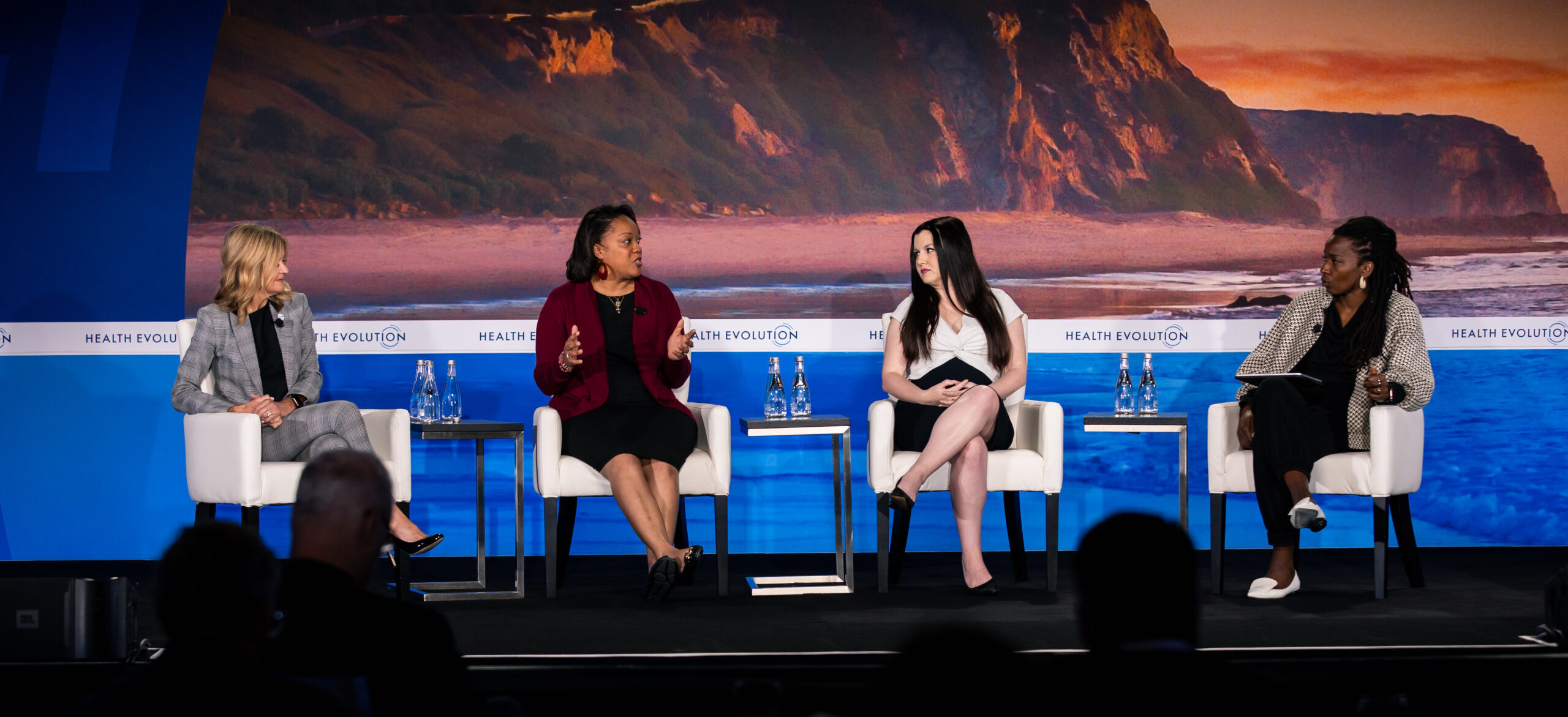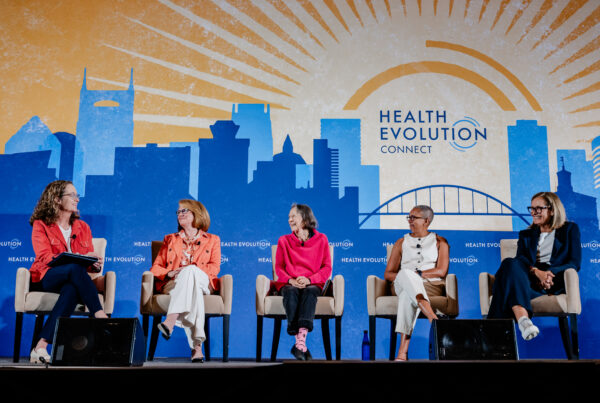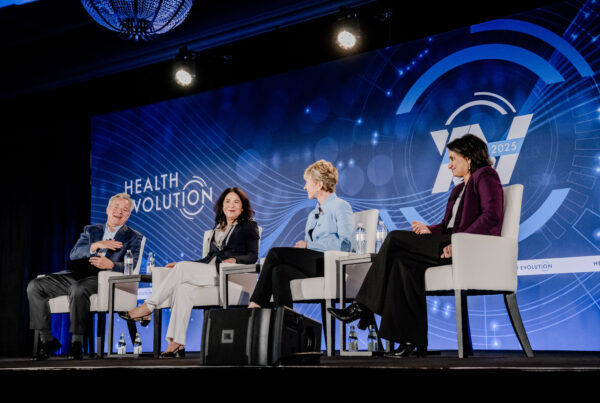The movement to end food insecurity and improve nutrition in the United States is gaining momentum. A range of innovators are working to confront food-related disparities and expand food as medicine programs. But how do innovators and incumbents collaborate to overcome the practical barriers to scaling these programs in a sustainable way?
At Health Evolution’s 2023 Summit, industry experts and leaders came together to address that question. Toyin Ajayi, MD, Co-Founder & CEO, Cityblock, moderated a discussion titled “Food and Health – Unpacking Efforts to Advance Food as Medicine and End Food Insecurity,” featuring leaders Shavana Howard, Senior Advisor for Food, Nutrition, and Consumer Services, United States Department of Agriculture (USDA); Mikelle Moore, former Chief Community Health Officer, Intermountain Healthcare; and Fidji Simo, CEO, Instacart.
During the conversation, leaders discussed how policymakers, technology companies, payers, providers, and others can work together to address food insecurity and promote food as medicine in ways that both scale and align with business priorities, making the programs sustainable while also expanding their impact.
Food insecurity affects health, but solving the problem is challenging
Growing research shows the relationship between food insecurity and a lack of access to healthy food with poorer health outcomes. “We know that to live healthy, fruitful lives, every person needs access to healthy, nutritious food,” Ajayi said. “And as we increasingly understand the drivers of chronic disease and worsening health outcomes, food insecurity or lack of access to the right types of food plays a huge role,” she added.
Recognizing this important link, the federal and state governments are deploying resources to ensure people can access services intended to both address food insecurity and increase people’s access to healthy foods. Howard noted, for example, that in 2022, there were 42 million people enrolled in USDA’s Supplemental Nutrition Assistance Program (SNAP), which was the highest enrollment the program has seen.
But despite high enrollment, SNAP isn’t serving as many people as it could be. “Nearly one out of four who are eligible for SNAP aren’t participating, so there’s a lot of people who are still not accessing these food benefits and could be food insecure,” Howard explained.
The same goes for USDA’s Special Supplemental Nutrition Program for Women, Infants, and Children (WIC). “We also are not serving as many people as we could in WIC,” Howard said. “Currently, about six million individuals are accessing WIC, which is only about 50% of the eligible population of parents and children. So we still have a lot of work to do” to ensure people in need are accessing the program, she noted.
According to Howard, stigma remains one of the biggest barriers to people accessing available resources. “Although there’s a lot of intentional effort that has been made over the last several years to increase access to these programs, part of the challenge is the stigma that’s associated with the programs and a lack of understanding of the benefits of those programs,” she said.
Ajayi agreed. “Ultimately, we’re talking about human beings who in the richest country in the world are hungry or are malnourished or do not have access to healthy, nutritious food sufficient to meet the needs of their body and of their medical conditions. That’s a travesty, and we exacerbate that by making them feel badly,” she said.
And although research shows the connection between access to nutritious food and health, “when we talk about food as medicine, it can feel nebulous and overwhelming,” Ajayi said. “As we start to narrow down and understand what role health care should play in this, such as what role we should play in funding or providing access to food, we don’t yet have the evidence base across all the spectrums that we need to start to tackle this work. And so there’s a lot here to really work through,” she explained.
Organizations can partner to boost access and reduce stigma
But Howard noted that health care and other organizations can partner with federal and state governments to increase access to programs that seek to address food insecurity and increase people’s access to healthy food.
“There’s great work that’s going on throughout the country and really connecting individuals with SNAP and WIC programs, and it seems to be very successful when it happens within the medical field,” Howard said. “The beauty in the work that providers do is patients listen to them, they trust their doctors. So if their doctor tells them that they need to connect to resources and they prescribe for them a program that can assist, they’re going to listen and they’re not going to feel that stigma associated that they would from someone else,” she explained.
Technology companies also can partner with government and other organizations to increase access to programs that address food insecurity and promote healthy foods. For example, Simo noted that Instacart was one of the pioneers in bringing the SNAP program online, which helped to raise awareness that the program exists and increase access to healthy foods.
“When you use SNAP online, you have a fundamentally different behavior than in store,” Simo said. She pointed to a study Instacart conducted in partnership with No Kid Hungry that found SNAP beneficiaries bought more produce when they shopped online vs. in stores without increasing their total grocery bill. “And the reason is that, online, they can manage their budget better, they can remove some items to make space for produce and fresh food, they don’t have the stigma in store of having to pay with their SNAP card nor of having to mentally calculate whether they’re still in their budget and having to put items back on the shelves at checkout. And so there’s a lot of benefits with bringing these programs online,” Simo explained.
Simo said Instacart is looking to broaden those impacts by partnering with health care organizations to integrate other types of food benefit programs into its platform. “Can payers start having the equivalent of a SNAP program where they start funding some of that? We’ve seen some innovation there in the Medicare space, and in the future, we’d ideally make it so that Instacart has a wallet where you can use your SNAP dollars, you can use your Medicare dollars, you can use any funds available to you that make it so that you have an incentive toward healthy eating,” she said.
Providers also can play a role. “There’s tremendous opportunity for collaboration in these spaces because providers have lots of data” that can identify patients in need of services, Moore said. For example, providers can use “predictive analytics to identify patients who are likely to be food insecure and also at greatest risk for exacerbation of comorbidities,” and then “contact them proactively to reduce stigma and ask them about their nutrition needs, as well as other social needs,” she said.
Simo agreed, noting that Instacart’s partnerships with providers “are critical in identifying who is food insecure and connecting them with the right programs.”
“If you look at the partnership we have with some providers, these providers help people get online on Instacart. They teach them how to download the app to their phone, help them fill out their SNAP application, and then have them connect their SNAP dollars onto Instacart. That can only happen at the local and community level, and then technology can help that scale,” Simo explained.
Partnerships can help align food as medicine efforts with business priorities
Ajayi noted that, while programs like SNAP and WIC and Instacart’s platform offer “real scale in addressing barriers to meet gaps” for millions of people, some people “need orders of magnitude and more help and support than everyone else, and those people tend to drive the most cost in the health care system.”
“That’s where the intersection with health systems becomes really interesting,” Ajayi said, “Thinking about things like medically tailored meals, for example, which is one place where the evidence base is really compelling in health care for a return on investment (ROI).” She noted that providing pre-made meals tailored to a patient’s unique medical conditions for “frail seniors, people who are dually eligible for Medicare and Medicaid, and people with chronic physical health conditions who also struggle with lack of access to food” has “been associated over and over and over again with reducing acute admissions, reducing morbidity, and improving hemoglobin A1C levels.”
“These are real, meaningful, quantifiable impacts in health care,” Ajayi said.
Health systems can play a role in areas beyond where they’d see what they traditionally count as ROI, as well. “The way health systems think about food as medicine has a multi-level approach. There’s the interventions our most frail patients need, such as medically tailored meals, where there is that true ROI in terms of total cost of care, medical outcomes, and other things we care about in the very traditional health system framework,” Moore agreed. However, she added, “Beyond that, health systems also are thinking about what patients who aren’t yet in that frail environment need, and what is our role in creating access to food as medicine as more of a prevention strategy for avoiding the crisis and the need for that fully medically tailored meal.”
Moore noted that proactively connecting with patients around their nutrition needs allows health systems to “develop a relationship with patients who aren’t regularly showing up in our clinics and hospitals.” These patients typically “are the invisible patients who are likely to have some kind of tragic health event in the future, and so meeting them and getting to know them around food is actually easier than getting to know them around their conditions. And then developing a relationship with them, whether it’s over enrollment in SNAP or WIC or in providing access to food pantries and other resources, really makes sense” from a health and business perspective, Moore said.
Leaders agreed that making these types of connections with patients both bolsters overall health in communities and aligns with companies’ business goals.
“I think people assume very often that the societal good is at odds with the business case, and I think magic happens when the two get combined,” Simo said. “It’s not just societal good, even though I really believe we all need to care about that as a primary goal, but it also aligns with business objectives,” she noted.
Collaboration is key to creating efficient, sustainable solutions
But Simo added that collaboration between government, providers, payers, community-based organizations, and companies such as Instacart is key. “I see the role of technology as really making things more efficient,” so “you can take these health care dollars and feed them into a system that scales and sustains impact over time,” she said.
Simo added, “I hope that payers start to realize that the same business case applies to them, and that providers really start embracing things like this. I think we are at the point where the data is going to prove the business case and we can start building on that.”
Moore agreed that partnerships could help to drive progress on addressing food insecurity and access to healthy food in a more sustainable way. “There’s an opportunity to really create greater efficiency” and address the “tremendous gaps” that currently exist, she said, “but it’s best if it happens collaboratively.”
“There is something about being present with people and talking about how to prepare food. Having a caregiver, a nurse, or a social worker in a clinical setting, say ‘we have a food pantry in the lobby of our hospital. Let’s walk you down there and teach you how to eat.’ Those things matter,” Moore said. “But,” she added, “then if you’re connecting those patients to an ongoing sustainable way to access food,” such as assistance from programs available through government agencies and integrated platforms like Instacart, “it gets much more legs.”
So organizations must collaborate, and “health care systems have a great opportunity to convene partners in their communities and try to create a sense of safety, shared objectives, and frequent communication” that can broaden the impact of food as medicine programs, Moore said, adding, “We have to work together.”










